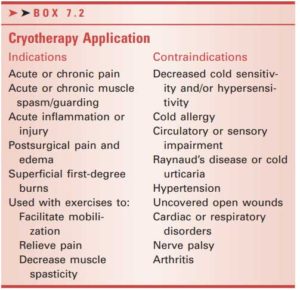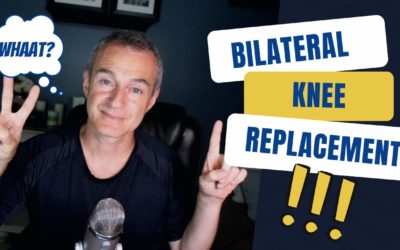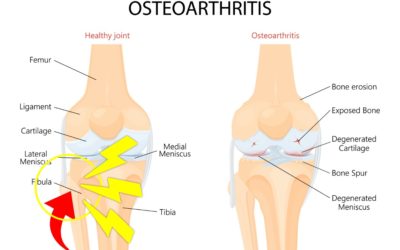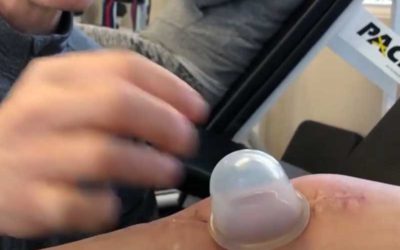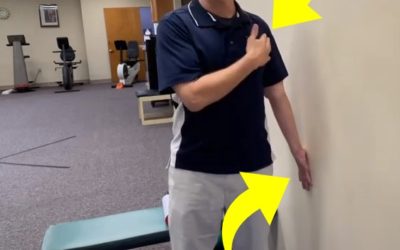How long should I ICE my knee after knee replacement?
Article Updated 06/08/2022
How long should I ice my knee after knee replacement surgery?
After a total knee replacement surgery many surgeons will often recommend icing the knee as often as possible.
In this article, I will review the current myths and misconceptions about using cryotherapy after knee replacement surgery and what is the number 1 reason to consider icing.
3 of the Most Common Myths Around Icing After Surgery:
- Icing reduces inflammation
- Icing reduces swelling
- Icing helps to heal injured tissue
3 Actual Truths Behind Icing After Surgery:
- Cold therapy will numb the superficial nerve endings which may reduce the experience of pain.
- Cold therapy provides a novel stimulus for the central nervous system and may interrupt the transmission of information being perceived as threatening.
- Cold therapy is inexpensive and easy to use at home. It is convenient and provides you with a sense of control which may help empower you to take control of your pain.
What does the research suggest?
A 2007 study determined that only an analgesic effect was demonstrated with continuous cooling. This study also determined that 4 degrees Celsius (39.2 degrees Fahrenheit) was determined to be comfortable for most patients. [1] A 2012 study analyzing the possible benefits of R.I.C.E. was inconclusive. [2]
How long should I place ice on my knee?
According to Therapeutic Modalities “Cryotherapy is usually applied for 20 to 30 minutes for maximum cooling of both superficial and deep tissues.” In many physical therapy clinics, the common recommendation is 10-minutes of sustained application. A couple of considerations to determine the length of time ice is placed on your post-surgical knee include
- How cold is the ice pack?
- Are you placing a piece of cloth or other covering between the ice and your skin?
- Are you applying ice to a part of the body with a thicker fatty tissue layer?
When should an ice pack be avoided?
The following table comes from Therapeutic Modalities section II page 168 –
Myth Buster #1 – Cryotherapy does not reduce inflammation.
Inflammation is a chemical process within the body and is largely regulated by the immune system. Placing an ice pack on the skin to change the skin’s temperature will not significantly impact the chemical response to tissue injury and repair known as inflammation.
Myth Buster #2 – Icing reduces swelling
Swelling and edema are also regulated by chemical changes at the site of injury. Changes in temperature applied to the skin can not significantly change the chemistry deep under the skin. If a noticeable change in swelling is noted upon removal of an ice pack it is largely due to the mechanical compression of the ice pack squeezing the fluid out of the area and not due to the cold temperature of the ice pack.
Myth Buster #3 – Icing improves healing.
Since the healing response is autoregulated by the body’s immune system, changes in superficial skin temperature have not been shown to significantly affect healing times. The best-known evidence of healing tissue following surgery includes a short episode of rest followed by an active recovery guided by a physical therapist, occupational therapist, or other qualified healthcare professional.
Summary:
Based on the available evidence, I would recommend using either cold therapy or heat therapy solely for an analgesic benefit. I would advise against taking time away from a more active recovery to sit with an ice pack or heating pad on your knee. If cold or warmth feels good and helps bring relief between bouts of activity these modalities are generally considered low risk for complications and inexpensive.
The bottom line is to do what feels good while you are resting, but stay active and keep moving when possible.
Facebook Group Comments
Another trick that helped me, was carrying an old fashion ice bag around and keeping ice on my knees all day even while going on excursions. Most restaurants and QT‘s gas station will let you fill up a cup and pour it into your ice bag. This bag CVS
Cited References:

Anthony Maritato, PT
Physical Therapist
Anthony Maritato, PT has been a licensed physical therapist and private practice owner since 2006. Ohio license #PT011602.
Anthony has been passionate about helping patients recover from total knee replacement surgery as well as rotator cuff repair surgery.
About the Author -
Anthony Maritato, PT has been a licensed physical therapist since 2006. He specializes in post surgical care and rehabilitation of total knee replacement and rotator cuff repair surgery.
Mr. Maritato is also nationally recognized as a therapist educator teaching courses related to Medicare reimbursement, contracting, and documentation.
Total Therapy Solutions LLC is Tony's primary practice which he owns with his wife Kathy who is also a licensed physical therapist.
More Blog Posts …
8 Pickleball Mistakes to Avoid for Beginners
Updated June 03, 2022 One of the main factors that cause beginners to experience setbacks when learning pickleball is doing too much too fast. Throught his article I will discuss the most common 8 pickleball mistakes along with some exercises you can try to prevent...
How much does physical therapy cost after a total knee replacement?
Phyiscal therapy cost varies greatly across locations and service providers. In this article we will examine the cost of physical therapy services for three different patients. One patient has traditional Medicare part B insurance. The second patient has no health...
3 Pros & Cons of Bilateral Knee Replacement
Having a bilateral knee replacement on the same day vs different days depends largely on your surgeon's assessment of your condition and current clinical research. A 2020 study suggested that patients receiving a same day bilateral knee replacement were not more...
Best shoes to wear after knee replacement
Best shoes to wear after knee replacement surgery:This article is specifically written to help you choose the best shoes to wear after knee replacement surgery when you return home. This information is focused on house-shoes and day 1 to week 6 post op.Click here to...
NEW Orthotics After Knee Replacement
Do You Need New Orthotics After Knee Replacement Surgery? Often, patients who receive a total knee replacement will have previously been prescribed custom orthotics. Custom orthotics may help reduce stress at the knee joint in the months or years before knee surgery...
Pain on the Outside of Knee After Total Knee Replacement
Experiencing pain on the outside of knee is common among individuals who have had a total knee replacement. 1. Fibular Head (Outside of Knee) The long skinny bone that runs along the outside of your lower leg is called the Fibula. This bone is not directly involved...
Cupping Therapy After Total Knee Replacement
Although the risk of major medical complications attributed to cupping therapy is low, the efficacy of cupping therapy is poorly associated with post surgical care and total knee replacement scar tissue mobilization.Cupping Therapy Research As of March 21, 2022 a...
Do physical therapists make house calls?
Do physical therapists make house calls? Find the answer to this and questions like: How much does physical therapy cost? Will a physical therapist come to my office? What is MobilePT?
Return to Work After Knee Replacement Surgery
When can I return to work after knee replacement surgery? For most administrative jobs, a 6-week timeframe to return to work after knee replacement surgery is recommended. For occupations that require prolonged standing, walking, climbing or crawling a 12+ week...
3 Drills to CRUSH your POWER Pickleball Serve
Pickleball is a power sport. Developing a Power pickleball serve requires yuo to be both strong and fast. Power is defined as the amount of work divided by the change in time. In order to improve power, a pickleball player must possess three things: Table of Contents...
